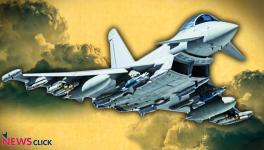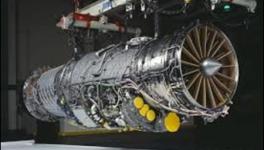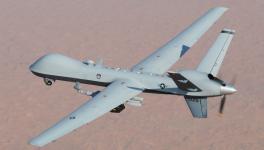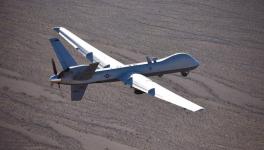Rafale Scam: ‘For Want of a Nail the Kingdom Was Lost’
File Photo :Rafale: Do French Senate Documents Nail Modi’s Lie?
The Rafale scam is one component of the Modi Sarkar’s policy to undermine public sector defence units, including ‘navratnas’, such as Bharat Electronics Ltd or Hindustan Aeronautics Ltd. In the process jeopardising and hollowing out the country’s security. Worried over the depleting squadron strength of its air fleet, the Indian Air Force (IAF) wanted 126 fighter jets. The number of fighter jets was arbitrarily reduced to 36 by Prime Minister Narendra Modi. On April 10, 2015, standing next to French President Francois Hollande, he announced the new deal. In a way, he did away with indigenous production of 108 fighter jets, its maintenance and servicing as well as robbed Hindustan Aeronautics Ltd (HAL) of capability building to meet any external threat. By reducing the number of fighter jets, the Modi Sarkar robbed the IAF of acquiring six squadrons.
Reduction in number has meant that IAF, which needed 42 squadrons, will not only see the squadron strength remain inadequate at 31, but that there is likelihood of further depletion in the strength of IAF. How?
Instead of retaining a bare minimum of aircraft needed for the country’s defence, there is going to be further depletion. Eighty Jaguar fighters were to be upgraded by buying 180 Honeywell engines, 160 for 80 Jaguars plus 20 spare engines. However, the price quoted by Honeywell of $2.4 billion, wrote defence analyst Ajai Shukla, was deemed far too high by the IAF. Per engine cost at $13.3 million was nearly twice the price quoted in 2013 for the engine, which was then quoted at less than $6 million. Indeed, Honeywell also quoted a price of $1.6 billion for integrating the engine to Jaguar airframe, aero analysis, flight testing & certification. Which was more than five times the price quoted by HAL of $300 million. This stand-off with Honeywell for Jaguar means further delay in upgrading Jaguars and, therefore, the likelihood of Jaguars having to be retired, affecting IAF’s squadron strength.
There will be acceleration of depletion in the strength of IAF also because HAL has been unable to provide upgraded Mirage 2000s on time. By now HAL ought to have delivered 21 refurbished Mirage but only seven have been provided. IAF blames HAL. The fact of the matter is that it is Dassault (the manufacturer of Mirage) which has declared that it does not have the Mirage 2000 kit to supply to HAL. The reason is that Dassault discontinued its production of Mirage 2000 series several years ago, and so it is futile to blame HAL for this. Newsclick’s defence analyst D Raghunandan has pointed out that when Mirage production was being terminated in France, they had offered both the Atal Bihari Vajpayee-led National Democratic Alliance government as well Manmohan Singh -led United Progressive Alliance government buying its assembly line by HAL. This was not done.
The long and short of it is that in the four-and-a-half years, a ‘strong & decisive’ government led by an all-powerful Prime Minister’s Office, instead of reversing this, has ensured that not only will there be a delay in supply of fighter jets but actually it may have contributed through its poor governance in hollowing out key areas of the country’s security.
The fear is that the combined weight of Modi Sarkar’s Rafale deal, cutting fighter jets requirement to 36 from 126, and delaying procurement of engines for Jaguars and kit from Dassault, the IAF squadron strength may get reduced well below 31 in the next few years.
What is even more disconcerting is that having cancelled the MMRCA (Medium Multi-Role Combat Aircraft) 2012 deal, settling for just 36 and then floating another round of tender for 100 plus fighter jets, has added another three-year delay in finalising the new deal, partly because of the general elections.
One of the critical issues to be clinched is how much of local content there should be in the ‘Make in India’ format. The authorities are tilting towards 45% local content, well below 70% that the MMRCA 2012 deal had struck. But the Rafale scam may have prevented them from rushing in with this new sweetener for foreign Original Equipment Manufacturers, the military behemoths. So much for governance.
The remarkable thing is also that the Modi Sarkar seems to be working for the benefit of Dassault and has gone out of its way to keep the company happy. This does not make sense, because in such deals, the buyer always has an edge to strike a better deal and payment terms. Instead, the Modi Sarkar, a paragon of “national pride”, has already paid Dassault 50% of the total cost of Rs 64,000 crore (€3.9 billion). That is, the Modi Sarkar has given a bonanza to Dassault without delivery of a single fighter jet and minus any bank guarantee. This at a time when HAL has not been paid Rs 14,500 crore owed to it by IAF for products delivered and services rendered or contracted to pay. Instead, the Modi Sarkar rushed to give away Rs 34,000 crore out of IAF’s capital budget of Rs 39,000 crore to Dassault.
Another act of generosity for Dassault was brought to light by the veteran journalist and chairman of The Hindu Group, N Ram. This brings out that Dassault charged €1.3 billion for 13 India-Specific Enhancements (ISE) which drove up the cost of each fighter jet as this cost had to be spread over 36 fighters instead of 126, as envisaged under the MMRCA 2012 nearly done deal. Now Dassault can recover all the cost of development in merely three years by selling 36 jets, as against 10 years under the MMRCA 2012 deal for 126.
Besides, the development cost of ISE is a one-time non-recurring payment. Which means that the follow-up purchase would have made future purchase cheaper. But Modi the Sarkar decided not to buy any more Rafale. An even more remarkable act of generosity shown for Dassault by the Modi Sarkar is that ISE, as per Newsclick’s defence expert D Raghunandan, which ought to be a property of India, will belong to Dassault, which can use and sell this to other buyers, all thanks to the Indian public subsidising their development cost.
This brings me to HAL. Robbing HAL of the contract for manufacturing 108 jets was not the only attack launched against it by the Modi Sarkar. First, the government announced that it would no longer fund defence public sector units and that they must raise funds from the money market. See how this worked for HAL.
First, the Modi Sarkar ensured that a cash-rich company with a surplus of Rs 11,699 crore and its December 2017 order book showed Rs 68,461 crore worth contracts was run dry. They forced HAL to increase payment of dividend to the government and they paid out in four years Rs 4000 crore. Then the government forced them to buy 10% of governments shares at an inflated price of Rs 1,200 per share or so. Thus, HAL parted with Rs 6,000 crore. Then they forced HAL to come out with an initial public offer where its shares were priced then at Rs 1,215-1,240 range. The current price is Rs 775 i.e. 40% less than quoted in early 2018.
Moneycontrol.com of March 16, 2018, while listing the risks and concerns of HAL’s IPO mentions:
“As the defence contracts are not always fully funded at inception and are subject to termination, inability of HAL to fund such contracts at the time of inception or contract termination could have a material adverse effect”.
This caveat is a strong argument in favour of retaining 100% ownership by Government of defence public sector units because unlike other companies, Government is tHE monopoly buyer and, therefore, depending on the threat scenario, orders can be placed and withdrawn. This is the inherent nature of THE military sector. The fear of war with neighbours can recede, for instance, because of successful politico-diplomatic engagement. As former Defence Minister Manohar Parrikar, in his public spat with industrialist Anil Ambani, had pointed out that only public sector can afford idle capacity because of change in the security scenario. What he did not say but implied is that a private player, out for profit-making, will not accept idle capacity and demand compensation for doing nothing and suffering profit loss. The point to note is that step-by-step DPSUs, such as HAL and others, are being pulled down, driven by the dogma that private sector for military production is the way ahead.
This dogma enables gratification of crony companies close to the supreme leader. Which is what happened in the new Rafale deal.
This is something like the nursery rhyme, “for want of nail, the shoe was lost. In this instance, it seems that in order to accommodate and land a novice and failed corporate crony 70% of the Rs 32,000 crore lucrative offset servicing, set in motion a series of linked developments. Such as accelerated depletion of squadron strength of the IAF by delaying acquisition. Lack of funds to complete sanctioned upgradation, financially ruining HAL -- all of which may augment hollowing out the backbone of military preparedness, the public defence sector and, therefore, the country’s security.
Get the latest reports & analysis with people's perspective on Protests, movements & deep analytical videos, discussions of the current affairs in your Telegram app. Subscribe to NewsClick's Telegram channel & get Real-Time updates on stories, as they get published on our website.
























